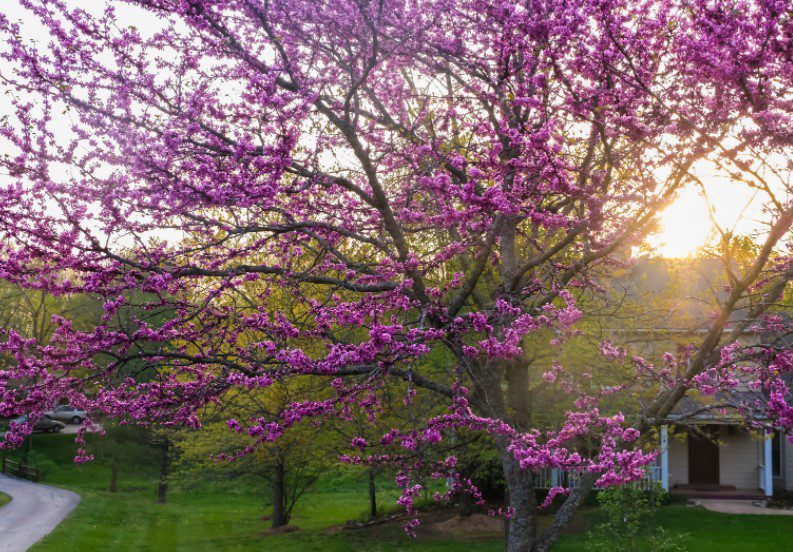Redbud Tree
Redbud trees are relatively small trees with spreading branches and small, short trunks. It is a popular ornamental tree in the mountains. The tree is among the earliest flowering trees, adding color to mountain gardens and streetscapes.
In early spring, the purplish-pink flowers of the redbud suddenly pop out all over the tree. The flowers can be seen even on large trunks. Redbud trees turn yellow in the fall and are tolerant of shade.
Small, potted redbud trees are fast to establish, and spring dormant planting is best. Redbud trees form a taproot and resent transplanting.
Choose the location where you intend for your redbud tree to stay. It is usually the tree’s seventh year before it begins to blossom. Birds and other wildlife eat redbud seeds.
The redbud tree does not take too much room and fits easily into most mountain gardens.
It requires little care or pruning. Once a year, fertilize lightly, and sit back and enjoy the springtime show.
Planting Redbud Tree
Planting a redbud tree is like getting married — you hope it will last a lifetime, but no matter how much you love your tree when you first plant it, if you treat the object of your affections badly, it will become a liability. That’s why it’s so important to select the right tree and plant it properly.
There are numerous reasons to plant redbud trees, They help the environment and minimize soil erosion. They increase your property value and they’re beautiful.
Trees almost always lend grace to the landscape, adding shade, greenery, privacy and birds. So it’s not a question of whether you should have trees; it’s more a matter of getting the right ones.
The time is ripe
Fall is a top time of year to plant redbud trees or any other tree. Moisture is plentiful and roots can get a heats start on the next growing season before the ground freezes.
It’s best to plant evergreens when deciduous trees turn color and deciduous trees after the first hard frost.
For best success, follow these guidelines:
– Dig a shallow broad hole three times the diameter, but no deeper than, the root ball.
– Always lift the tree by the root ball, not by the trunk.
– Check that the tree sits straight in the hole.
– Avoid planting too deep; the flare at the base of the trunk should be above soil level.
– With a tree wrapped in burlap, remove any string, wire and fabric from the base of the trunk; cut away excess burlap near the top, but leave the remaining material in place to avoid disturbing the roots (fabric breaks down naturally).
– Once the tree is in place, backfill the hole about one-third full, packing soil around the root ball to get rid off air pockets; water in; then fill completely, again packing down firmly.
The care of your redbud tree
– Water thoroughly at least once a week. Trees need the equivalent of 2.5 centimetres of rain every week to 10 days.
– Don’t fertilize until the second growing season.
– Apply a five- to 10-centimetre layer of organic material (cedar mulch or shredded pine) to the soil at the base to conserve moisture, reduce competition from grass and weeds and
keep string trimmers away from the bark. Don’t mound mulch too high at the trunk’s flare.
– Most trees don’t require staking — new trees develop roots and solid trunks more quickly if they’re not staked.
– If you must stake, use wide flexible tying material to protect the bark. Remove it before the second growing season.
– At planting, do only minor pruning. Remove any dead twigs or branches damaged during shipping or planting; postpone further pruning for a full growing season.
Trees sold three ways
1. Bare root, no soil (usually small trees)
– Roots should be moist, not crushed or torn, and ends should be cleanly cut.
– Prune off any injured portions of roots just before planting. Make straight cuts.
2. Roots in a ball and wrapped in burlap
– Roots and soil are held in place by burlap, sometimes contained in a wire basket.
– Trunk flare should be visible; avoid trees buried in fabric.
– Root balls should be flat on top and firm to the touch.
– Root ball diameter should be 10 to 12 times the diameter of the trunk when measured 15 centimetres above the flare.
3. In a container
– Roots shouldn’t circle in the container; circling roots often girdle and kill other roots and put pressure on the bark, causing damage later.
– If there are a few circling roots, cut them away.
– Trunk flare should be obvious; avoid trees planted too deep in containers.
Watch for injuries
– Always look under the trunk wraps for wounds, incorrect pruning cuts and insect damage (wrap may be used to protect the trunk during transit; remove it when planting).
– Incorrect pruning cuts that remove or injure the swollen collar at the base of branches and cuts that leave damage can create problems, such as cankers, decay and cracks.























